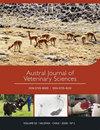Current attitudes towards the use of perioperative analgesics in small animals by Uruguayan veterinarians
IF 0.5
4区 农林科学
Q3 VETERINARY SCIENCES
引用次数: 0
Abstract
. In recent decades, several articles have reported significant progress regarding pain treatment in veterinary medicine. This study aims to analyse the attitudes of veterinarians working in small animal practices in Uruguay towards the use of analgesics during the perioperative period. Veterinarians in charge of clinics performing surgeries were interviewed, including clinics located in the capital city, Montevideo (n=59) and the rest of the country (n=81), based on data obtained from the National Veterinary Census in 2010. Most interviews were conducted in person, and if not possible, they were carried out through video calls. According to gender, 54% of interviewees were women and 46% were men, with 95% of them practising in urban areas. The most used drugs were nonsteroidal anti-inflammatory drugs (NSAIDs), with dipyrone (89%) being the most popular. Amongst opioids, pure agonists presented minimal inclusion in analgesic treatment (13%), with tramadol (93%) being the most used opioid. Drugs belonging to other groups were less mentioned. Thirty-eight per cent of the respondents considered that their training in pain management was inadequate. Veterinarians categorised the intensity of pain caused by several surgical procedures as “severe”, however, they used weak opioids such as tramadol or NSAIDs as a single therapy to treat most cases. The scarce use of analgesic drugs and techniques that provide profound analgesia (such as mu-opioid receptor agonists) by Uruguayan veterinarians reveals the need for open discussion, adjustment of attitudes and continuing education on pain management.乌拉圭兽医目前对小动物围手术期使用止痛药的态度
. 近几十年来,有几篇文章报道了兽医在疼痛治疗方面取得的重大进展。本研究旨在分析乌拉圭从事小动物实践的兽医对围手术期使用镇痛药的态度。根据2010年全国兽医普查获得的数据,对负责进行手术的诊所的兽医进行了访谈,包括位于首都蒙得维的亚(n=59)和该国其他地区(n=81)的诊所。大多数采访都是面对面进行的,如果不可能的话,也会通过视频电话进行。按性别划分,54%的受访者为女性,46%为男性,其中95%在城市地区执业。使用最多的药物是非甾体抗炎药(NSAIDs),以双吡酮(89%)最受欢迎。在阿片类药物中,纯激动剂在镇痛治疗中的应用最少(13%),曲马多(93%)是使用最多的阿片类药物。属于其他群体的药物较少被提及。38%的受访者认为他们在疼痛管理方面的培训是不够的。兽医将几种外科手术引起的疼痛强度归类为“严重”,然而,他们使用曲马多或非甾体抗炎药等弱阿片类药物作为治疗大多数病例的单一疗法。乌拉圭兽医很少使用镇痛药物和提供深度镇痛的技术(如mu-阿片受体激动剂),这表明需要公开讨论,调整态度和继续教育疼痛管理。
本文章由计算机程序翻译,如有差异,请以英文原文为准。
求助全文
约1分钟内获得全文
求助全文
来源期刊

Austral Journal of Veterinary Sciences
Veterinary-General Veterinary
CiteScore
1.60
自引率
0.00%
发文量
18
期刊介绍:
Austral Journal of Veterinary Sciences (formerly Archivos de Medicina Veterinaria) publishes original scientific contributions in English, containing the latest developments and discoveries in veterinary sciences. The journal covers topics such as animal health and production, preventive medicine, zoonosis, pharmacology and therapeutics, methods of diagnosis, and other areas related to the veterinary field.
Austral Journal of Veterinary Sciences aims to divulge information about advances in veterinary medicine among universities, research centres, industries, government agencies, biologists, agronomists and veterinarians.
 求助内容:
求助内容: 应助结果提醒方式:
应助结果提醒方式:


